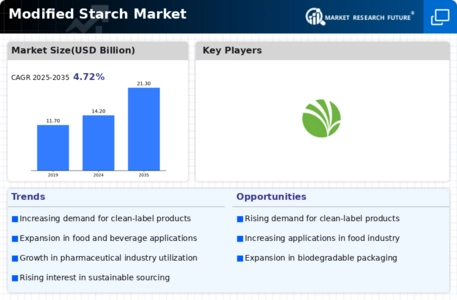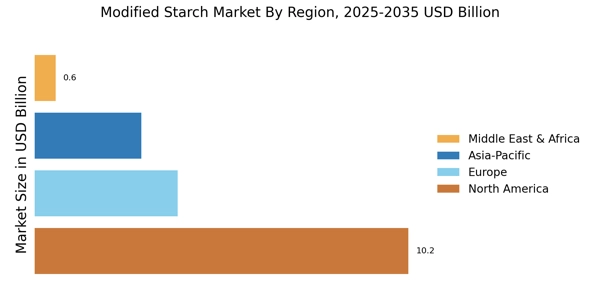Increasing Health Consciousness
The Modified Starch Market is experiencing a notable shift as consumers become increasingly health-conscious. This trend is reflected in the rising demand for food products that are perceived as healthier and more natural. Modified starches, often used as thickeners and stabilizers, are being favored for their ability to enhance texture without compromising nutritional value. According to recent data, the market for modified starches is projected to grow at a compound annual growth rate of approximately 5.5% over the next few years. This growth is driven by the food and beverage sector, where manufacturers are reformulating products to meet consumer preferences for clean-label ingredients. As a result, the Modified Starch Market is likely to see a surge in innovation aimed at developing healthier alternatives.
Rising Demand for Convenience Foods
The Modified Starch Market is witnessing a surge in demand for convenience foods, which is reshaping the landscape of food production. As lifestyles become increasingly fast-paced, consumers are gravitating towards ready-to-eat and easy-to-prepare meals. Modified starches play a crucial role in these products, providing desirable textures and extending shelf life. Market analysis suggests that the convenience food segment is expected to grow at a rate of 4.8% annually, which will likely drive the demand for modified starches. This trend indicates that manufacturers in the Modified Starch Market must adapt to changing consumer preferences by developing innovative solutions that cater to the convenience food sector.
Sustainability Trends in Food Production
The Modified Starch Market is increasingly influenced by sustainability trends in food production. As consumers and manufacturers alike become more aware of environmental issues, there is a growing emphasis on sustainable sourcing and production practices. Modified starches, derived from renewable resources, are being recognized for their potential to contribute to more sustainable food systems. Market data indicates that the demand for sustainably sourced ingredients is on the rise, with consumers willing to pay a premium for products that align with their values. This trend is likely to encourage manufacturers within the Modified Starch Market to invest in sustainable practices, thereby enhancing their market position and appeal to environmentally conscious consumers.
Expansion of the Food and Beverage Sector
The Modified Starch Market is significantly influenced by the expansion of the food and beverage sector. As this sector continues to grow, the demand for modified starches is expected to rise correspondingly. Modified starches are widely utilized in various applications, including sauces, dressings, and baked goods, where they serve to improve texture and shelf life. Recent statistics indicate that the food and beverage industry is projected to reach a valuation of over 8 trillion by 2026, which could further bolster the modified starch market. This expansion is likely to create new opportunities for manufacturers to innovate and diversify their product offerings, thereby enhancing their competitive edge within the Modified Starch Market.
Technological Innovations in Starch Modification
The Modified Starch Market is benefiting from ongoing technological innovations in starch modification processes. Advances in production techniques are enabling manufacturers to create modified starches with enhanced functionalities, such as improved solubility and stability under varying conditions. These innovations are crucial for meeting the diverse needs of various industries, including food, pharmaceuticals, and cosmetics. Recent developments in enzymatic and chemical modification methods have expanded the range of applications for modified starches. As a result, the Modified Starch Market is likely to experience growth driven by these technological advancements, which could lead to the introduction of new products that meet specific consumer demands.


















Leave a Comment